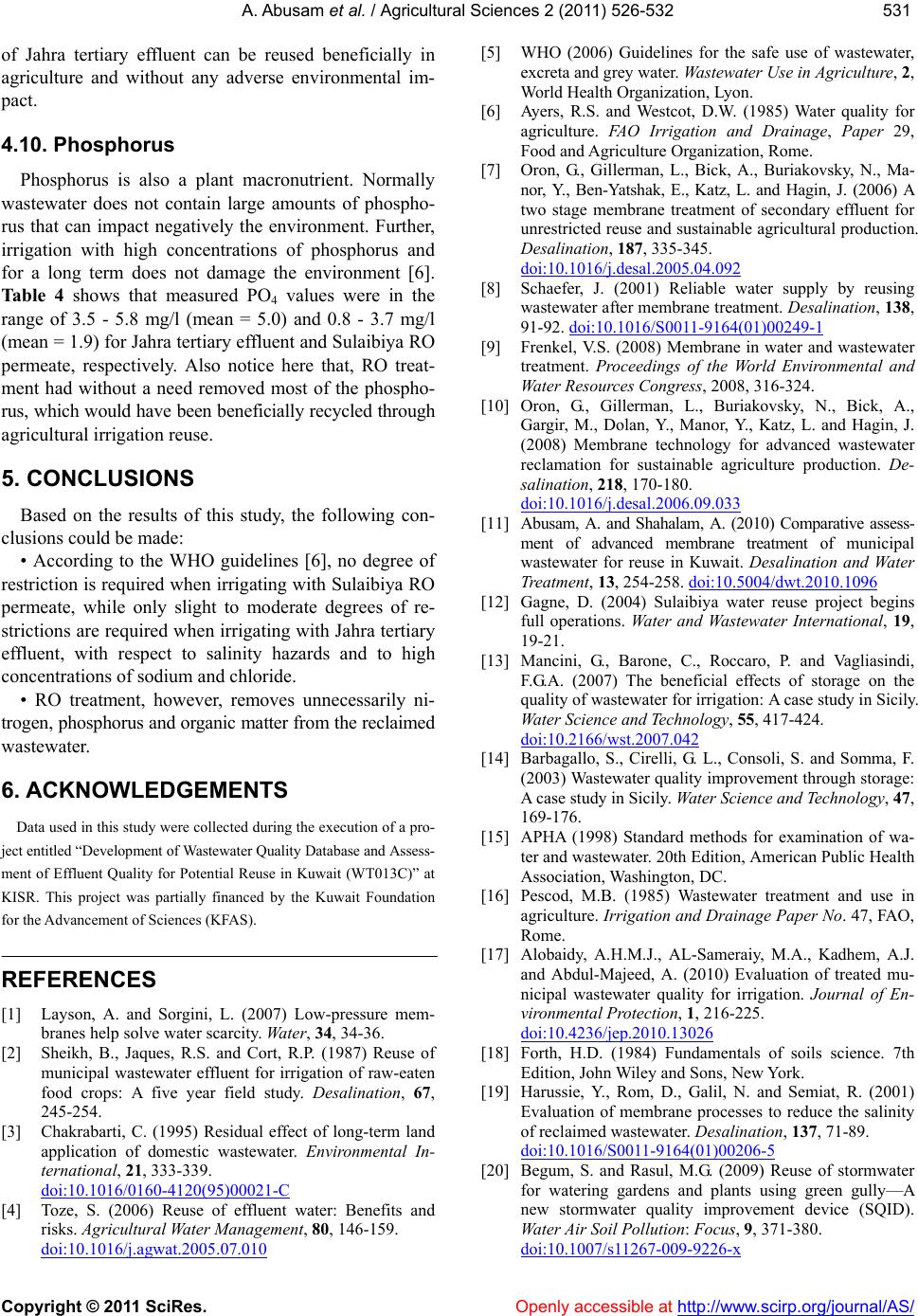
A. Abusam et al. / Agricultural Sciences 2 (2011) 526-532
Copyright © 2011 SciRes. Openly accessible at http://www.scirp.org/journal/AS/
531531
of Jahra tertiary effluent can be reused beneficially in
agriculture and without any adverse environmental im-
pact.
4.10. Phosphorus
Phosphorus is also a plant macronutrient. Normally
wastewater does not contain large amounts of phospho-
rus that can impact negatively the environment. Further,
irrigation with high concentrations of phosphorus and
for a long term does not damage the environment [6].
Table 4 shows that measured PO4 values were in the
range of 3.5 - 5.8 mg/l (mean = 5.0) and 0.8 - 3.7 mg/l
(mean = 1.9) for Jahra tertiary effluent and Sulaibiya RO
permeate, respectively. Also notice here that, RO treat-
ment had without a need removed most of the phospho-
rus, which would have been beneficially recycled through
agricultural irrigation reuse.
5. CONCLUSIONS
Based on the results of this study, the following con-
clusions could be made:
• According to the WHO guidelines [6], no degree of
restriction is required when irrigating with Sulaibiya RO
permeate, while only slight to moderate degrees of re-
strictions are required when irrigating with Jahra tertiary
effluent, with respect to salinity hazards and to high
concentrations of sodium and chloride.
• RO treatment, however, removes unnecessarily ni-
trogen, phosphorus and organic matter from the reclaimed
wastewater.
6. ACKNOWLEDGEMENTS
Data used in this study were collected during the execution of a pro-
ject entitled “Development of Wastewater Quality Database and Assess-
ment of Effluent Quality for Potential Reuse in Kuwait (WT013C)” at
KISR. This project was partially financed by the Kuwait Foundation
for the Advancement of Sciences (KFAS).
REFERENCES
[1] Layson, A. and Sorgini, L. (2007) Low-pressure mem-
branes help solve water scarcity. Water , 34, 34-36.
[2] Sheikh, B., Jaques, R.S. and Cort, R.P. (1987) Reuse of
municipal wastewater effluent for irrigation of raw-eaten
food crops: A five year field study. Desalination, 67,
245-254.
[3] Chakrabarti, C. (1995) Residual effect of long-term land
application of domestic wastewater. Environmental In-
ternational, 21, 333-339.
doi:10.1016/0160-4120(95)00021-C
[4] Toze, S. (2006) Reuse of effluent water: Benefits and
risks. Agricultural Wa ter Management, 80, 146-159.
doi:10.1016/j.agwat.2005.07.010
[5] WHO (2006) Guidelines for the safe use of wastewater,
excreta and grey water. Wastewater Use in Agriculture, 2,
World Health Organization, Lyon.
[6] Ayers, R.S. and Westcot, D.W. (1985) Water quality for
agriculture. FAO Irrigation and Drainage, Paper 29,
Food and Agriculture Organization, Rome.
[7] Oron, G., Gillerman, L., Bick, A., Buriakovsky, N., Ma-
nor, Y., Ben-Yatshak, E., Katz, L. and Hagin, J. (2006) A
two stage membrane treatment of secondary effluent for
unrestricted reuse and sustainable agricultural production.
Desalination, 187, 335-345.
doi:10.1016/j.desal.2005.04.092
[8] Schaefer, J. (2001) Reliable water supply by reusing
wastewater after membrane treatment. Desalination, 138,
91-92. doi:10.1016/S0011-9164(01)00249-1
[9] Frenkel, V.S. (2008) Membrane in water and wastewater
treatment. Proceedings of the World Environmental and
Water Resources Congress, 2008, 316-324.
[10] Oron, G., Gillerman, L., Buriakovsky, N., Bick, A.,
Gargir, M., Dolan, Y., Manor, Y., Katz, L. and Hagin, J.
(2008) Membrane technology for advanced wastewater
reclamation for sustainable agriculture production. De-
salination, 218, 170-180.
doi:10.1016/j.desal.2006.09.033
[11] Abusam, A. and Shahalam, A. (2010) Comparative assess-
ment of advanced membrane treatment of municipal
wastewater for reuse in Kuwait. Desalination and Water
Treatment, 13, 254-258. doi:10.5004/dwt.2010.1096
[12] Gagne, D. (2004) Sulaibiya water reuse project begins
full operations. Water and Wastewater International, 19,
19-21.
[13] Mancini, G., Barone, C., Roccaro, P. and Vagliasindi,
F.G.A. (2007) The beneficial effects of storage on the
quality of wastewater for irrigation: A case study in Sicily.
Water Science and Technology, 55, 417-424.
doi:10.2166/wst.2007.042
[14] Barbagallo, S., Cirelli, G. L., Consoli, S. and Somma, F.
(2003) Wastewater quality improvement through storage:
A case study in Sicily. Water Science and Technology, 47,
169-176.
[15] APHA (1998) Standard methods for examination of wa-
ter and wastewater. 20th Edition, American Public Health
Association, Washington, DC.
[16] Pescod, M.B. (1985) Wastewater treatment and use in
agriculture. Irrigation and Drainage Paper No. 47, FAO,
Rome.
[17] Alobaidy, A.H.M.J., AL-Sameraiy, M.A., Kadhem, A.J.
and Abdul-Majeed, A. (2010) Evaluation of treated mu-
nicipal wastewater quality for irrigation. Journal of En-
vironmental Protection, 1, 216-225.
doi:10.4236/jep.2010.13026
[18] Forth, H.D. (1984) Fundamentals of soils science. 7th
Edition, John Wiley and Sons, New York.
[19] Harussie, Y., Rom, D., Galil, N. and Semiat, R. (2001)
Evaluation of membrane processes to reduce the salinity
of reclaimed wastewater. Desalination, 137, 71-89.
doi:10.1016/S0011-9164(01)00206-5
[20] Begum, S. and Rasul, M.G. (2009) Reuse of stormwater
for watering gardens and plants using green gully—A
new stormwater quality improvement device (SQID).
Water Air Soil Pollution: Focus, 9, 371-380.
doi:10.1007/s11267-009-9226-x